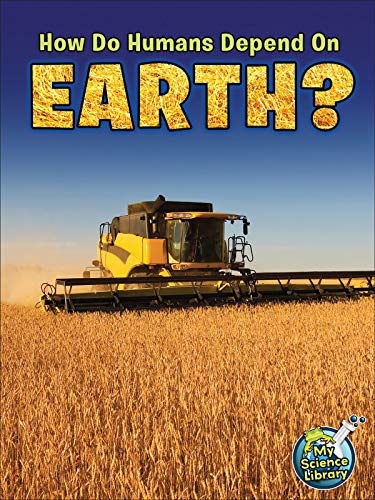-
Eating and The Digestive System
Julie Lundgren
Paperback (Rourke Educational Media, Aug. 1, 2012)In Eating and the Digestive System, readers will learn how animals and humans eat to fuel their bodies, repair themselves, and handle daily functions. Featuring real-life photographs, fascinating facts, a comprehension and extension section, and more, readers stay engaged while learning and strengthening their reading comprehension skills. My Science Library's rich, content-filled text and beautiful photographs bring science and the scientific process to life for readers. The series includes interesting facts about the Earth, the solar system, matter, energy, forces and motion, and life on our planet. The engaging text makes learning about science fun. S
S
-
Why Plants Become Extinct
Julie Lundgren
Paperback (Rourke Educational Media, Aug. 1, 2012)Students Will Learn How Plants Are Becoming Endangered Or Even Extinct Due To Changes In Climate, Deforestation To Build New Homes, Or By Invasive Plant Species That Are Brought From Other Places. How Plants Make Adaptations To Survive Their Ever Changing Habitats Is Also Discussed. M
M
-
Scoop About Measuring Matter
Tracy Maurer
Paperback (Rourke Educational Media, Aug. 1, 2012)Matter Is Anything That Has Mass, And This Title Teaches Students About How Temperature Affects The Different States Of Matter And Why. Talks About The International System Of Units And Measuring Mass And Volume. Q
Q
-
What Is It Made Of?
Amy S. Hansen
Paperback (Rourke Educational Media, Aug. 1, 2011)Emergent Readers Learn To Recognize Different Materials Such As Wood, Metal, And Plastic. K
K
-
Zap! It's Electricity!
Buffy Silverman
Paperback (Rourke Educational Media, Aug. 1, 2011)Intermediate Readers Explore Electricity. N
N
-
Gravity! Do You Feel It?
Buffy Silverman
Paperback (Rourke Educational Media, Aug. 1, 2011)Intermediate Readers Explore Concepts Of Gravity. M
M
-
La energia a nuestra alrededor
Buffy Silverman
Paperback (Rourke Educational Media, Aug. 1, 2012)This Title Explains How All Forms Of Energy Belong To One Of Two Groups; Potential Or Kinetic. It Addresses How Energy Can Be Used In The Form Of Water To Create Electricity, In The Form Of Solar To Heat Our Homes, And In The Form Of Wind To Turn The Blades On A Wind Turbine. S
S
-
Los cambios de la materia
Tracy Nelson Maurer
Paperback (Rourke Publishing, Aug. 1, 2012)This Title Teaches Students That Everything Is Made Of Matter, And That Physical Changes Create Different Forms Or States Of Matter. Gives Examples Of These Different States In Easy To Understand Text And Introduces Students To The Law Of Conservation Of Mass. N
N
-
Animal World
Laura Howell, Kirsteen Rogers, Corinne Henderson, Judy Tatchell, Verinder Bhachu
Library Binding (Edc Pub, April 1, 2002)Provides information on the various parts of animal bodies and how they are adapted to the ways different kinds of animals live and move, discusses environmental issues, and recommends related Web sites. X
X
-
Let's Investigate Light
Buffy Silverman
Paperback (Rourke Educational Media, Aug. 1, 2012)With An Emphasis On How Important Light Is To Our Earth, This Title Explains How Light Effects Photosynthesis, How Light Travels, The Different Properties Of Light And How Both Animals And People Depend On It. Whether It's Ultraviolet Light That Help Bees Pollinate Flowers To Solar Panels That Use The Sun's Light To Heat Our Homes, It's All Addressed In This Beautifully Illustrated Book. M
M
-
My Life Science Library Do Plants Have Babies?
Lisa Amstutz
Paperback (Discovery Library Jr, Aug. 11, 2019)Do plants have babies? Yes, they do! My Life Science Library: Do Plants Have Babies? introduces young readers in kindergarten to grade 2 to plants and how they reproduce. Early elementary readers will learn about sexual and asexual plant reproduction in this easy-to-read book.This collection introduces a variety of natural science topics for early learners based on life science NGSS standards. From amazing animal builders to plant reproduction, these books present complicated information in easy-to-understand language and provide kid-friendly examples. Each book includes an activity that supports further comprehension M
M
-
How Do Humans Depend On Earth?
Julie Lundgren
Paperback (Rourke Educational Media, Aug. 1, 2012)The Importance Of Plants And Our Dependence On Them Not Only For Food But Also For Our Clean Air And Water Are Discussed In This Title. How Crops And Plants Have Been Genetically Modified To Resist Disease And Insects. The Impact Humans Have On Our Earth And What We Can Do To Reduce The Use Of Our Nonrenewable Resources Are Discussed. R
R